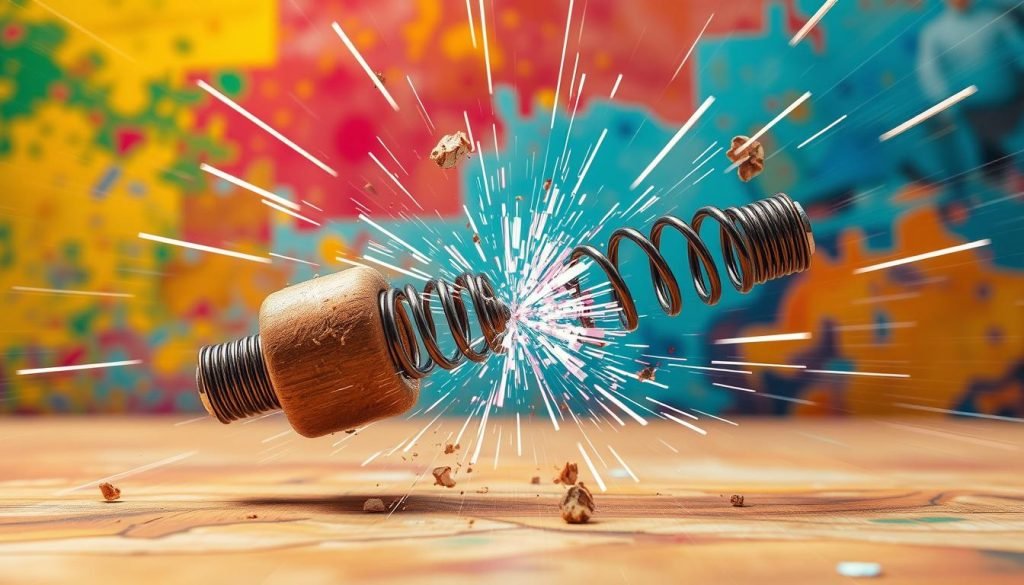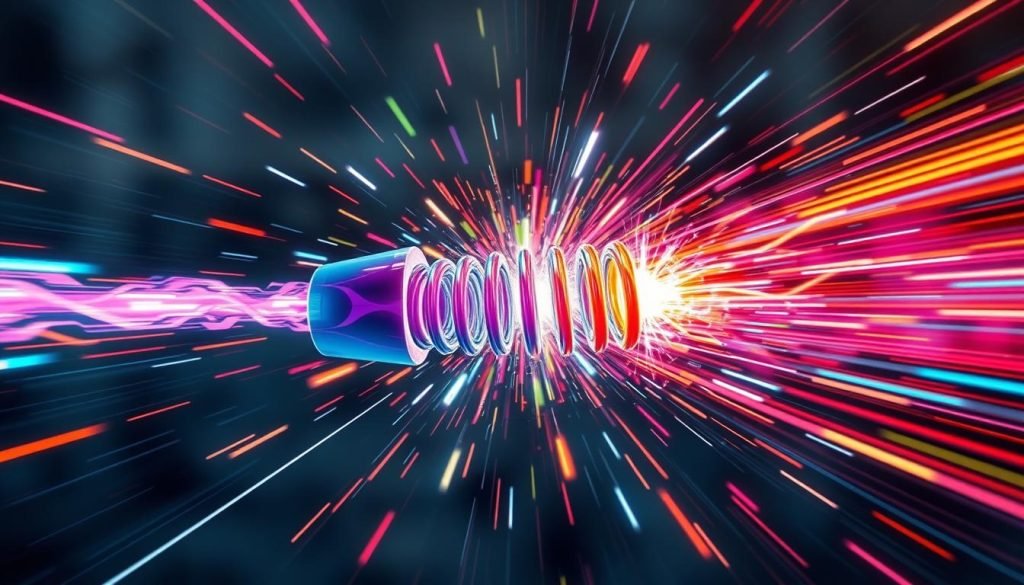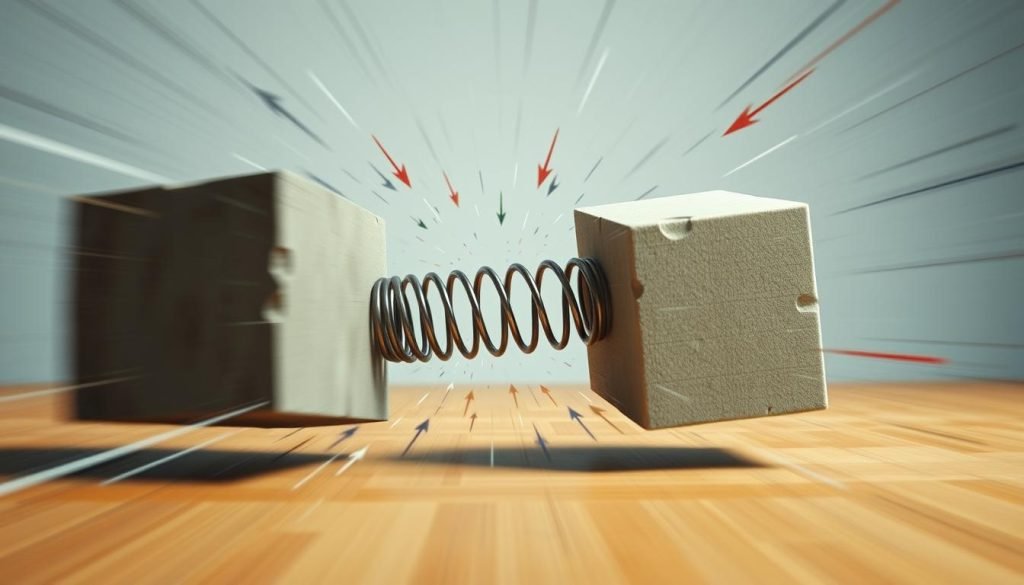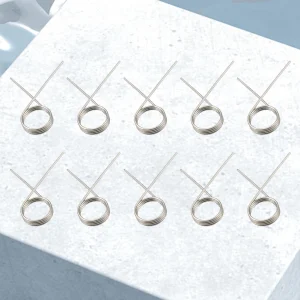Momentum conservation is a key idea in physics. It’s important to understand how it works in different situations. When springs are involved in collisions, things get a bit more complicated.
Spring mechanics are key to figuring out what happens in these collisions. Knowing how momentum and spring mechanics work together is essential. It helps us understand the dynamics of spring-based collisions.
Studying momentum and spring mechanics helps us understand how objects move. By looking at how momentum applies to springs, we learn more about their interactions. This knowledge is vital in physics and engineering.
It helps in designing new systems and technologies. Understanding momentum and spring mechanics is key to innovation.
Understanding Basic Momentum Conservation
Momentum conservation is key in physics. It helps us understand how objects move and collide. The momentum of an object is its mass times its velocity. This concept is vital for studying different types of collisions.
In physics, we use momentum to track how objects move before and after they hit each other. The total momentum in a closed system never changes. This means that the momentum one object gains is exactly what another loses. This idea is important for understanding how objects behave in collisions.
What is Momentum in Physics?
Momentum shows how much an object is moving and how heavy it is. It’s a vector, meaning it has direction. You can find an object’s momentum by multiplying its mass by its velocity. This is a basic rule in studying how objects collide.
The Principle of Conservation of Momentum
The principle of conservation of momentum says that a closed system’s total momentum stays the same over time. This rule is key for understanding how objects behave in different types of collisions. It helps us see how energy is stored or released during these events.
Types of Collisions in Physics
Physics recognizes two main types of collisions: elastic and inelastic. In elastic collisions, the energy is kept, and objects bounce back. In inelastic collisions, energy is lost, and objects stick together. Knowing about these types is essential for studying how objects interact.
- Elastic collisions: The total kinetic energy is conserved, and the objects bounce back with the same velocity.
- Inelastic collisions: The total kinetic energy is not conserved, and the objects stick together after the collision.
Introduction to Spring Mechanics
Spring mechanics is a key area in physics that looks at how springs act in collisions. The elastic energy in a spring is very important. It helps in energy transfer during collisions. Knowing about spring mechanics helps us understand how momentum and energy work together.
When a spring gets compressed or stretched, it stores elastic energy. This energy then moves to other objects or systems. It changes how these objects move and act in a collision. By studying spring mechanics, we learn about the links between spring constants, how far it stretches, and the force it applies. These are key to understanding how energy moves around.
- Spring constants and their impact on energy transfer
- Displacement and force relationships in springs
- Elastic energy storage and release
These ideas are important for understanding how springs behave in different types of collisions. By looking into spring mechanics and energy transfer, we can better understand how particles and systems interact in physics.
| Concept | Description |
|---|---|
| Spring Constants | Measure of a spring’s stiffness and ability to store energy |
| Elastic Energy | Energy stored in a spring due to compression or stretching |
| Energy Transfer | Process of transferring energy from one system to another during a collision |
Is Momentum Conserved if a Spring is in the Collision?
Momentum conservation is a key idea in physics. It’s interesting to see how it works in spring collisions. The elastic energy in the spring changes how momentum is saved.
The elastic energy in springs is very important in collisions. When a spring gets compressed or stretched, it stores energy. This energy can move to the objects in the collision, changing their momentum.
The Role of Elastic Potencial Energy
Elastic energy is stored in springs when they are stretched or compressed. The formula to find this energy is: Elastic Energy = (1/2) * k * x^2. Here, k is the spring constant and x is how far it’s moved from its middle position.
Energy Transfer During Spring Collisions
In a spring collision, the stored energy moves from the spring to the objects. This energy change follows the law of energy conservation. It says the total energy before the crash equals the total energy after.
Mathematical Analysis of Spring-Mass Systems
Spring-mass systems are used to study spring collisions. By solving the motion equations, we can find out the position and speed of objects over time. This helps us understand how momentum is saved in these collisions.

Studying momentum in spring collisions is very useful in physics and engineering. Knowing how energy and momentum work together is key for designing and testing systems with springs and collisions.
| Spring Constant (k) | Displacement (x) | Elastic Potencial Energy |
|---|---|---|
| 10 N/m | 0.5 m | 1.25 J |
| 20 N/m | 0.2 m | 0.8 J |
Different Types of Spring-Involved Collisions
When it comes to collision types, springs can play a big role. They affect how a collision ends. In spring mechanics, we see different kinds of collisions, like elastic and inelastic ones.
Elastic collisions keep both momentum and kinetic energy the same. This means the total energy before the crash is the same after. Spring mechanics are key here, as the spring’s energy turns into motion.
On the other hand, inelastic collisions lose kinetic energy. This energy often turns into heat or sound. The collision types with springs can be broken down into perfectly elastic, perfectly inelastic, and partially elastic ones.
Knowing about the different collision types and spring mechanics is vital. It helps us understand and predict what happens in spring-related crashes. By understanding each type, we see how springs interact with other objects in a crash.
The Conservation of Energy in Spring Systems
Energy conservation is key in physics, and it’s vital in spring systems. When a spring is in a collision, energy moves and changes forms. Understanding energy conservation helps us see how springs and objects interact.
Spring systems convert kinetic and elastic energy. As a spring moves, it stores energy that later turns into motion. This shows how energy moves and stays the same in spring systems.
Kinetic Energy During Collision
Kinetic energy is about motion, and it’s important in spring systems. In a collision, kinetic energy moves between objects. Knowing about kinetic energy helps us understand spring system behavior.
Potential Energy Storage
Potential energy is stored energy due to an object’s position. In springs, this energy builds up as it moves. The spring’s constant and how far it moves from its center point affect this energy. Knowing about this energy is key to understanding spring systems.
| Energy Type | Description |
|---|---|
| Kinetic Energy | Energy of motion |
| Potential Energy | Energy stored in an object due to its position or configuration |
In conclusion, energy conservation is vital in spring systems. It’s important to know how kinetic and elastic energy change. By looking at kinetic energy in collisions and elastic energy storage, we can grasp how springs work and why energy conservation matters.
Real-World Applications of Spring Collisions
Spring collisions play a big role in many fields like cars, space, and making things. Knowing how springs work in collisions helps make better systems. These systems use elastic collisions.
Here are some ways spring collisions are used:
- Shock absorbers in cars use springs to soak up shock from bumps.
- In space, springs help launch satellites and other spacecraft.
- Manufacturing uses springs to sort and put together parts.
These uses depend on the science of spring collisions. This science helps engineers make systems that work well and safely. They aim to lose less energy and do better.

Spring collisions also help in robotics and medical devices. As technology gets better, knowing about spring collisions becomes even more important.
| Industry | Application | Benefits |
|---|---|---|
| Automotive | Shock absorbers | Improved safety and comfort |
| Aerospace | Spring-based launch systems | Increased efficiency and accuracy |
| Manufacturing | Spring-based sorting and assembly systems | Improved productivity and reduced costs |
Common Misconceptions About Springs and Momentum
When we talk about springs and momentum, many myths come up. One big myth is mixing up energy and momentum. It’s key to know the difference to understand how springs work. The spring constant is important here because it shows how much energy a spring can hold.
Some people think energy and momentum always stay the same in spring collisions. But that’s not right. Energy does stay the same in perfect spring collisions. Yet, momentum also stays the same, but it’s a different thing. The spring constant, which shows how stiff a spring is, changes how the spring and collision behave.
The Difference Between Energy and Momentum Conservation
Let’s look at a simple example to see the difference. When a spring is compressed and then released, its energy turns into kinetic energy. At the same time, the spring and object’s momentum stays the same. The spring constant decides how much energy is stored and the system’s momentum.
Spring Constants and Their Impact
Spring constants really matter in how springs work. A higher spring constant means a stiffer spring. This means more energy is stored in the spring. Knowing about spring constants is vital for designing and studying spring systems, like in engineering and physics.
By understanding and fixing these myths, we learn more about springs and momentum. This knowledge is key in physics, engineering, and materials science. Springs are important in many systems’ design and function.
Laboratory Experiments and Measurements
Conducting laboratory experiments is key to understanding momentum in spring collisions. These experiments use springs and masses to measure momentum before and after a collision. Data analysis is vital in making sense of these results.
A typical setup includes a spring and a mass, which collide with another mass. By measuring momentum before and after, researchers check if it’s conserved.
Common data collection methods include:
- Using sensors to measure the velocity of the masses before and after the collision
- Utilizing high-speed cameras to capture the motion of the system
- Employing data acquisition software to record and analyze the data
By analyzing the data, researchers deepen their understanding of momentum conservation. This knowledge is critical for advancing physics.
| Experiment | Momentum Before Collision | Momentum After Collision |
|---|---|---|
| Spring-Mass System | 10 kg*m/s | 10 kg*m/s |
| Spring-Mass System with Friction | 10 kg*m/s | 8 kg*m/s |
Practical Examples and Calculations
To show how spring collisions work, let’s look at some practical examples. These examples will help us see how momentum stays the same in real situations. We’ll solve sample problems and explain each step clearly.
Here are a few examples:
- A ball attached to a spring hits a stationary object. We can figure out the ball’s momentum before and after the hit.
- A spring-mass system models a real collision. We can analyze the energy change during the hit and find the final momentum.
By exploring these practical examples and calculations, we learn more about momentum conservation. We see how it works in spring collisions.
Conclusion: Understanding Spring Collisions and Conservation Laws
In this article, we’ve looked into the world of momentum and spring collisions. We’ve seen that even with springs, the laws of physics, like momentum conservation, are always true. By understanding how energy moves in these collisions, we learn a lot about how things work in the real world.
The main point is that momentum always stays the same, even with springs in the mix. We’ve gone through the math and experiments to clear up any confusion. This shows us how complex and interesting these physical events can be.
As we wrap up, it’s clear that studying spring collisions and conservation laws is very important. It helps in many areas, like engineering, car design, sports, and even how our bodies work. By knowing more about these topics, we can keep improving science and technology.






